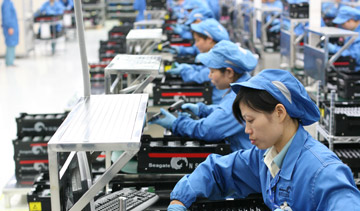 WASHINGTON — U.S. manufacturers have grown more competitive over the past decade compared with factories in China, Brazil and most of the worlds other major economies.
WASHINGTON — U.S. manufacturers have grown more competitive over the past decade compared with factories in China, Brazil and most of the worlds other major economies.
So says a new private study, which found that rising wages and higher energy costs have diminished Chinas long-standing edge over the United States. So has a boom in U.S. shale gas production. Its reduced U.S. natural gas prices and slowed the cost of electricity.
The Boston Consulting Group is issuing a report Friday on its study of manufacturing costs in the 25 biggest exporting countries. only seven of those countries had lower manufacturing costs than the United States did this year. And since 2004, U.S. manufacturers have improved their competitiveness compared with every major exporter except India, Mexico and the Netherlands.
In 2004, for example, manufacturing in China cost 14 per cent less than manufacturing in the United States. By this year, the China advantage had narrowed to 5 per cent. If the trends continue, Boston Consulting found, U.S. manufacturing will be less expensive than Chinas by 2018.
Over the past decade, labour costs, adjusted to reflect productivity gains, shot up 187 per cent at factories in China, compared with 27 per cent in the United States. The value of Chinas currency has risen more than 30 per cent against the U.S. dollar over the past decade.
The higher Chinese currency made goods produced in China and sold abroad comparatively more expensive. And foreign goods became comparatively more affordable in China.
Chinese electricity costs rose 66 per cent, more than double the United States 30 per cent increase. The start of large-scale U.S. shale gas production in 2005 has helped contain electricity bills in the United States and neighbouring Canada and Mexico.
China, too, has reserves for shale gas. But it will need years to develop them.
This is not something you can turn on overnight, said Justin Rose, a partner at Boston Consulting and co-author of the study.
Brazil has lost even more ground than China. In 2004, manufacturing was 3 per cent cheaper in Brazil than in the United States. By 2014, Brazil was 23 per cent more expensive. Brazilian factories didnt improve efficiency enough to offset rising energy and labour costs.
The countries wher manufacturing was cheaper than in the United States are Indonesia, India, Mexico, Thailand, China, Taiwan and Russia.
Australia was the most expensive country for manufacturing. Its costs were 30 per cent higher than those in the United States.
The survey doesnt include transportation costs, which vary depending on wher goods are shipped. Several countries also face obstacles not captured by Boston Consultings manufacturing cost index — from corruption to inefficient government bureaucracies.




